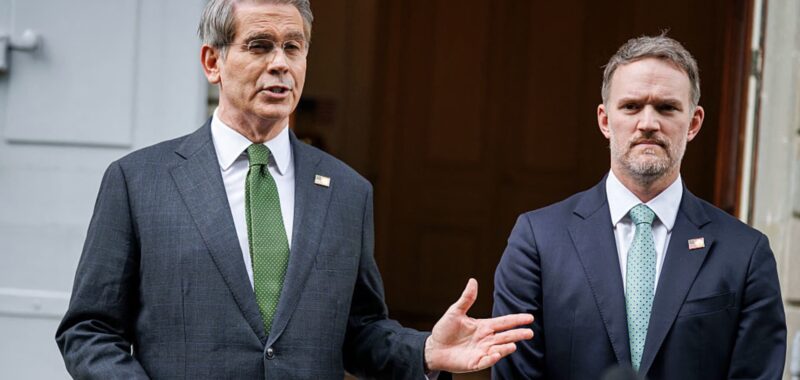US Treasury Secretary Scott Bessent (L) and US Trade Representative Jamieson Greer speak to the media after talks between senior US and Chinese officials on tariffs in Geneva on May 11, 2025.
Valentin Flauraud | Afp | Getty Images
The U.S. and China on Monday agreed to temporarily suspend most tariffs on each other’s goods in a move that shows a major thawing of trade tensions between the world’s two largest economies.
The trade agreement means that “reciprocal” tariffs between both countries will be cut from 125% to 10%. The U.S.’ 20% duties on Chinese imports relating to fentanyl will remain in place, meaning total tariffs on China stand at 30%.
The breakthrough comes after U.S. and China trade representatives held high-stakes talks in Switzerland over the weekend.
“We had very productive talks and I believe that the venue, here in Lake Geneva, added great equanimity to what was a very positive process,” U.S. Treasury Secretary Scott Bessent said in a news conference.
“We have reached an agreement on a 90-day pause and substantially move down the tariff levels. Both sides on the reciprocal tariffs will move their tariffs down 115%,” Bessent said.
The pause will begin on Wednesday. Both China and the U.S. said they will continue discussions on economic and trade policy.
Stocks jump on news of deal
Since returning to the White House in January, U.S. President Donald Trump has launched a flurry of aggressive trade measures that jolted financial markets and ratcheted up recession fears. The duties, which are designed to narrow the U.S. trade deficit, hit China particularly hard.
Trump had imposed tariffs of up to 145% on Chinese imports, prompting Beijing to respond with retaliatory curbs of its own, including restrictions on some rare earth elements.
Investors were buoyed by news of the tariff reprieve. Stateside, Nasdaq futures pointed to a 3.7% gain, with the S&P 500 futures higher by 2.7% and Dow up by more than 840 points, or 2%.
The ICE U.S. Dollar Index also rose sharply. The index, which measures the U.S. dollar against a basket of global currencies, was last up 1.1% to 101.46.
Elsewhere, the pan-European Stoxx 600 index rose by around 1% during mid-morning deals.
Oil prices also popped. International benchmark Brent crude futures with July expiry traded over 2.7% higher at $65.66 a barrel, while U.S. West Texas Intermediate futures stood at $62.81, up 2.9% for the session.
‘Keeps the pressure on’
Mark Williams, chief Asia economist at Capital Economics, described the trade war truce as “a substantial de-escalation.”
“However, the US still has much higher tariffs on China than on other countries and still appears to be trying to rally other countries to introduce restrictions of their own on trade with China,” Williams said in a research note.
“In these circumstances, there is no guarantee that the 90-day truce will give way to a lasting ceasefire,” he added.
Meanwhile, Tai Hui, APAC chief market strategist at J.P. Morgan Asset Management, said the magnitude of the U.S.-China tariff reduction was larger than expected.
“This reflects both sides recognizing the economic reality that tariffs will hit global growth and negotiation is a better option going forward,” Hui said in a research note.
“The 90-day period may not be sufficient for the two sides to reach a detailed agreement, but it keeps the pressure on the negotiation process,” he added.
Hui noted that investors were still waiting for further details on other trade terms, such as whether China would relax rare earth export restrictions.
â CNBC’s Ganesh Rao contributed to this report.

